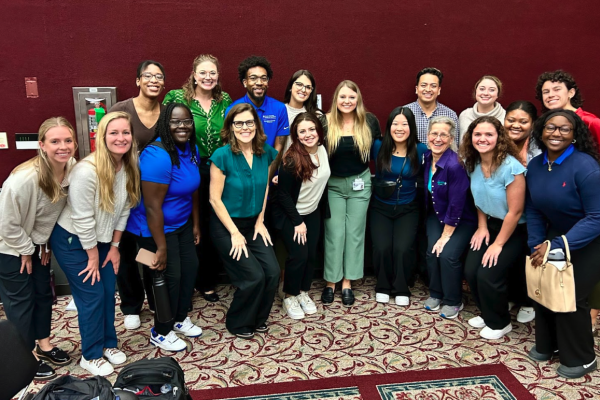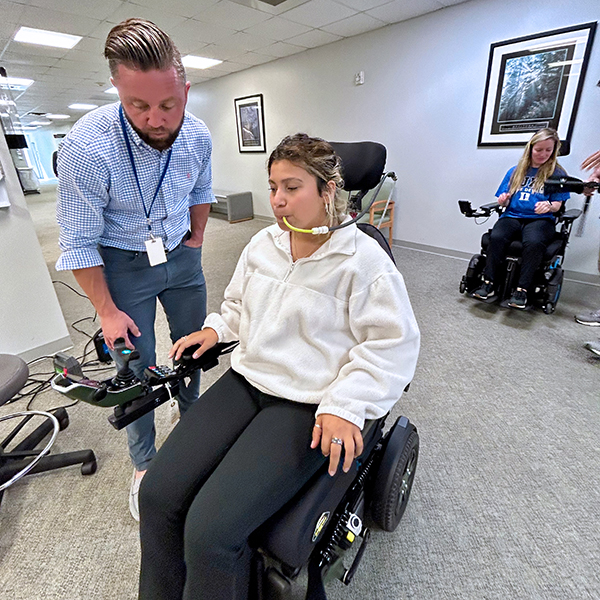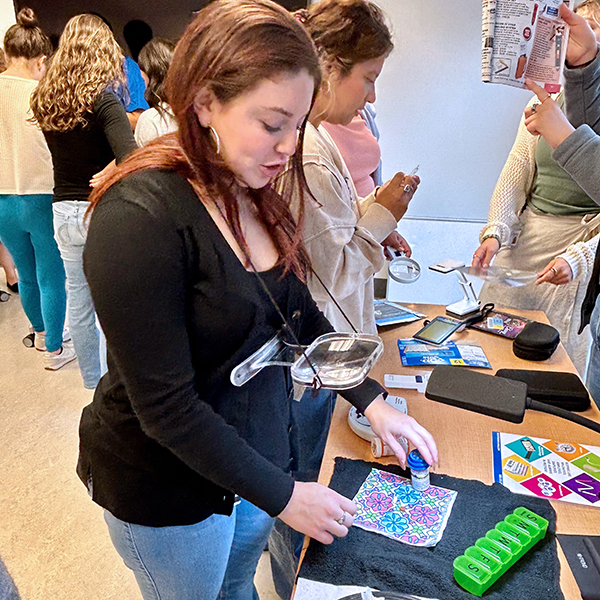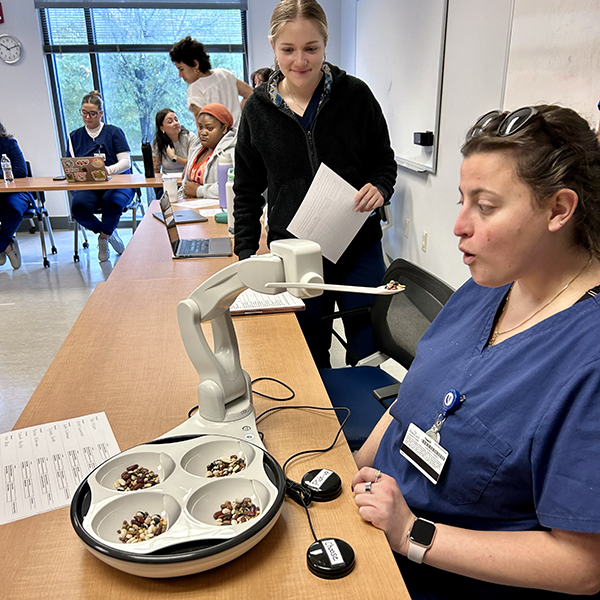
How can assistive technology turn barriers into bridges? In OTD 601: Occupation and Technology, students examine this essential question while gaining a thorough understanding of the complex relationship between technology, occupation, and well-being. This innovative course teaches future occupational therapists (OTs) how technological solutions can either improve or hinder daily activities, directly affecting their clients' health and quality of life.
Taught by Tami Atkins, MS, OTR/L, and Melissa L. Werz, OTD, OTR/L, the course positions assistive technology within a broader occupation framework as a key mechanism for health. By integrating these two models, students learn how technology can support their clients' values and participation in meaningful activities. “It’s gratifying to witness the expansion of students' critical reasoning skills and their growing understanding of occupational therapy's full scope and potential,” Tami said.
At the core of the course is a fundamental perspective shift: barriers to participation often stem from environmental and contextual factors rather than the individual. Students develop essential reasoning skills through hands-on experience with assistive tools and devices to assess, match, recommend, and teach clients how to leverage technology to support their occupations.
Hands-On with Wheeled Mobility
Theory meets practice in the wheelchair mobility unit, where students gain a practical understanding of aligning real-world case scenarios with the features of manual and powered wheelchair technology. Using the Interdependence-Human Activity Assistive Technology (i-HAAT) model, they learn to match human factors, socio-environmental elements, activity demands, and occupational goals to identify optimal mobility solutions (Lee et al., 2020).
The course emphasizes the importance of collaboration with clients, caregivers, and interdisciplinary teams throughout the decision-making process. Students explore evidence-based strategies and work with advanced tools like pressure-mapping sensors to analyze pressure points for appropriate wheelchair cushioning, ensuring future clients can maintain mobility, prevent pressure sores, and engage in essential activities.

Through interactive labs, students develop the expertise needed to integrate technology effectively into clients' daily lives. This hands-on approach transforms students into confident, tech-savvy practitioners prepared to enhance their clients' occupational engagement.
Collaboration with experts from interdisciplinary fields, such as assistive technology specialists, gives students real-world context and helps them build professional networks early in their education. This collaboration bridges the gap between academic learning and clinical practice, improving knowledge translation while exposing students to potential career paths in occupation-centered assistive technology.
Student Reflection:
“Using the wheelchair for the first time shattered my assumptions about how intuitive assistive technology would be. Navigating a simple hallway was challenging and required repetition, support, and increased environmental awareness. My biggest 'aha!' moment came when I realized that a wheelchair isn’t just a mobility tool—it’s a gateway to participation. As a future OT, I must carefully consider how a wheelchair’s size and functionality align with my client’s needs across their home, work, and community spaces to empower them truly.”
– Fatima Al-Sarakbi Hernandez, OTD Class of 2026
Low Vision Technology
Students explore a range of low-tech and high-tech solutions for individuals with low vision. From simple contrasting color washcloths to manage medication to cutting-edge devices like bioptic lenses and image-to-speech phone apps, students learn how these technologies support clients in maintaining independence in activities such as reading, cooking, and navigating their environment. Through hands-on practice, they gain essential skills in matching the right visual aids to clients' unique needs and occupational goals, reinforcing the vital role OTs play in helping individuals with visual impairments engage in meaningful activities.

Assistive Technology in the Home and Workplace
This study area explores how innovative devices can enhance independence and quality of life for individuals with disabilities. Students gain invaluable insights from North Carolina Assistive Technology Program (NCATP) professionals who demonstrate transformative solutions for enhancing autonomy at home and work. For instance, the Obi robotic feeding device enables individuals with limited upper extremity mobility to enjoy meals at their own pace. With four serving bowls and an arm that delivers food directly to the user’s mouth, this technology restores dignity and independence.

Through expert demonstrations, students learn how to evaluate and recommend assistive technologies that can dramatically improve clients' autonomy in daily activities, from self-feeding to workplace tasks.
Other topics covered in this survey course include community mobility and driving evaluations, school-based assistive technology, the OT's role in Augmentative and Alternative Communication (from core boards to calibrating eye-gaze devices), prosthetics, client-centered AT recommendations, AI literacy, virtual reality rehabilitation, and field trips to the NCATP Assistive Technology Expo.
“It’s gratifying to witness the moment when a student’s eyes light up upon discovering a specialized assistive technology niche that ignites their passions. This deepens their understanding of OTs' distinct role in the community, fostering a more inclusive world,” Tami said. “It’s a privilege to be a small part of their professional growth and discovery journey.”